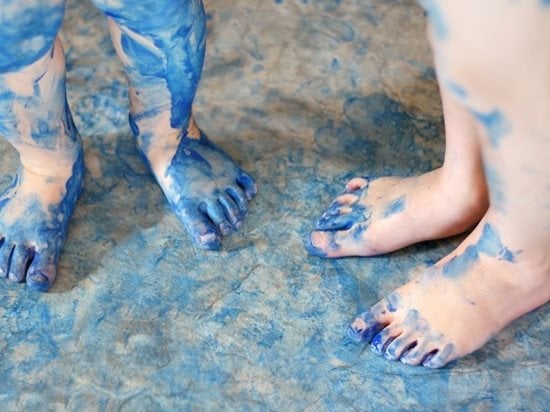- Concrete Cleaning Home
- Choosing a Concrete Cleaner or Degreaser
- How to Clean Exterior Concrete
- Concrete Cleaning Chemicals
- Pressure Washing Concrete
- Cleaning and Sealing Exterior Concrete: A Guide to Maintaining and Caring for Exterior Decorative Concrete of all Types
- Tips for Maintaining Exterior Concrete
- How to Clean Concrete
- How to Clean Concrete Floors
- How to Clean a Concrete Patio
- Cleaning a Concrete Driveway
- Cleaning Stamped Concrete
- Pool Deck Cleaning
- How to Clean Concrete Countertops
- How to Remove Stubborn Stains and Discoloration
- Advice on Cleaning Concrete Countertops, from Concrete-Countertops.org
- Related Information:
- Concrete Sealers
How to Remove Paint from Concrete
Tips and methods for removing paint spills on indoor and outdoor concrete
No matter how the paint got on your concrete, here are the best methods for removing it. Photo: Christin Lola / Shutterstock.
If you have ever accidentally spilled or splattered paint onto on a new concrete floor, patio, or other surface, you probably threw up your hands in despair, assuming the spot would be permanent. While paint spills on concrete may seem like a catastrophe, they are really nothing to cry over. In most cases, the paint can be removed successfully with a bit of time and effort.
Find concrete cleaning contractors near me.
The materials and methods required for paint removal will depend on a number of factors, including the type of paint (water vs. oil-based), the size of the spill, and the porosity of the concrete. Here are some of your options, along with a few tips for getting the best results.
PAINT STRIPPERS
Many of the same chemical strippers designed for removing paint from wood can also be used on concrete and masonry surfaces. Make sure the stripper is formulated for the type of paint you’re trying to remove. Some products will only remove water-based latex paint while others will work on both oil- and water-based paints.
Look for an environmentally friendly product that is safe to use on both indoor and outdoor concrete surfaces, such as BLUE BEAR Soy Gel 600GL Coatings Remover from Franmar. These strippers are typically thick gels that will stay active a long time after application. They also are biodegradable, low in odor, and free of caustic chemicals.
How to remove paint from concrete using chemical strippers:
- Apply a thick layer of paint stripper using a brush, broom, or squeegee, following the manufacturer’s instructions.
- Let the stripper sit until it fully penetrates and the paint begins to soften (anywhere from 4 to 24 hours).
- Remove the paint with a scraper or wire brush once it is visibly wrinkled or puckered.
- If any paint remains on the concrete, spread the stripper back over the area and allow it to work longer.
- Hose off or mop up any remaining residue.
- Clean the concrete with a degreaser.
Safety tip:
Don’t use paint strippers containing methylene chloride. These solvent-based strippers work fast, but they are highly toxic when inhaled or absorbed through the skin. Recently the EPA banned the sale of these paint strippers
POWER WASHING
Environmentally friendly paint strippers are effective, but the goopy mess they leave behind can be a hassle to dispose of. If the paint spill is on exterior concrete, power washing is a great alternative and avoids most of the cleanup.
How to get paint off concrete with a power washer:
For the best results, use a power washer with a pressure rating of at least 3000 psi and a flow rate of at least 4 gallons per minute. If you don’t want to invest in an industrial power washer, consider renting or borrowing one. You can also hire a professional to do the job.
See these tips for pressure washing concrete.
 All-Purpose Concrete Cleaner
Removes sealers and coatings.
All-Purpose Concrete Cleaner
Removes sealers and coatings.
 Cleaner & Degreaser
Starting at $11.95
Cleaner & Degreaser
Starting at $11.95
 Brickform Neutra Clean
A pH neutral cleaner that combines cleaning and light degreasing
Brickform Neutra Clean
A pH neutral cleaner that combines cleaning and light degreasing
 Commercial Surface Cleaners
Cuts through grease and grime. Environmentally friendly
Commercial Surface Cleaners
Cuts through grease and grime. Environmentally friendly
SODA BLASTING
For stubborn paint spills that can’t be removed by power washing or chemical strippers, an effective and environmentally friendly alternative is soda blasting. This method, which uses granular sodium bicarbonate (baking soda) blasted at high pressure onto the surface, can remove multiple layers of paint or coatings fast. It also is a less-aggressive paint removal method than sandblasting and won’t damage the concrete surface.
Removing paint from concrete using sodium bicarbonate:
Although you can rent soda blasting units from hardware stores and equipment rental companies, it takes some skill to operate the equipment properly and safely. Your best bet is to hire a professional soda blasting service.
If you do decide to do the job yourself, make sure you use an industrial-grade sodium bicarbonate (not the baking soda you buy at the grocery store) and take the appropriate safety precautions by wearing a respirator. Also, don’t let any overspray come in contact with plants because the high pH level of the material can be harmful.
FLOOR GRINDERS
Instead of using paint strippers, a chemical-free alternative for removing paint from concrete floors is by grinding it off using a walk-behind or handheld concrete grinder. These machines are very effective at removing thin coatings and paints or for cleaning and lightly abrading concrete floor surfaces.
How to remove paint from a concrete floor using a grinder:
You can rent handheld and small walk-behind concrete floor grinders at many home-improvement stores and equipment rental companies, along with the appropriate grinding disks. However, the equipment can be tricky to operate, especially for the inexperienced. Unless you know what you’re doing, you’re better off hiring a professional.
To control airborne dust particles, use a concrete floor grinder equipped with a vacuum port so it can be hooked up to an industrial vac. Not only will a vacuum keep the air free from harmful dust, it will also eliminate messy cleanup.
WHAT IF THE PAINT STILL WON'T COME OFF?
If you've tried everything and there's still paint left on your concrete, consider resurfacing your concrete. A coating is applied over the old surface giving you a clean, blank canvas that can be finsihed in your choice of colors, textures and patterns.
HOW TO INHIBIT PAINT ABSORPTION INTO CONCRETE
Bare, untreated concrete can act like a sponge and absorb paint and other unwanted stains readily, making them harder to remove. Keeping your concrete protected with a sealer or floor wax will help prevent absorption, allowing you to remove the spot more easily. If you get to the spill early before the paint dries, you can often remove it using only detergent and water. If the paint has dried, you may be able to simply scrape it off the surface.




